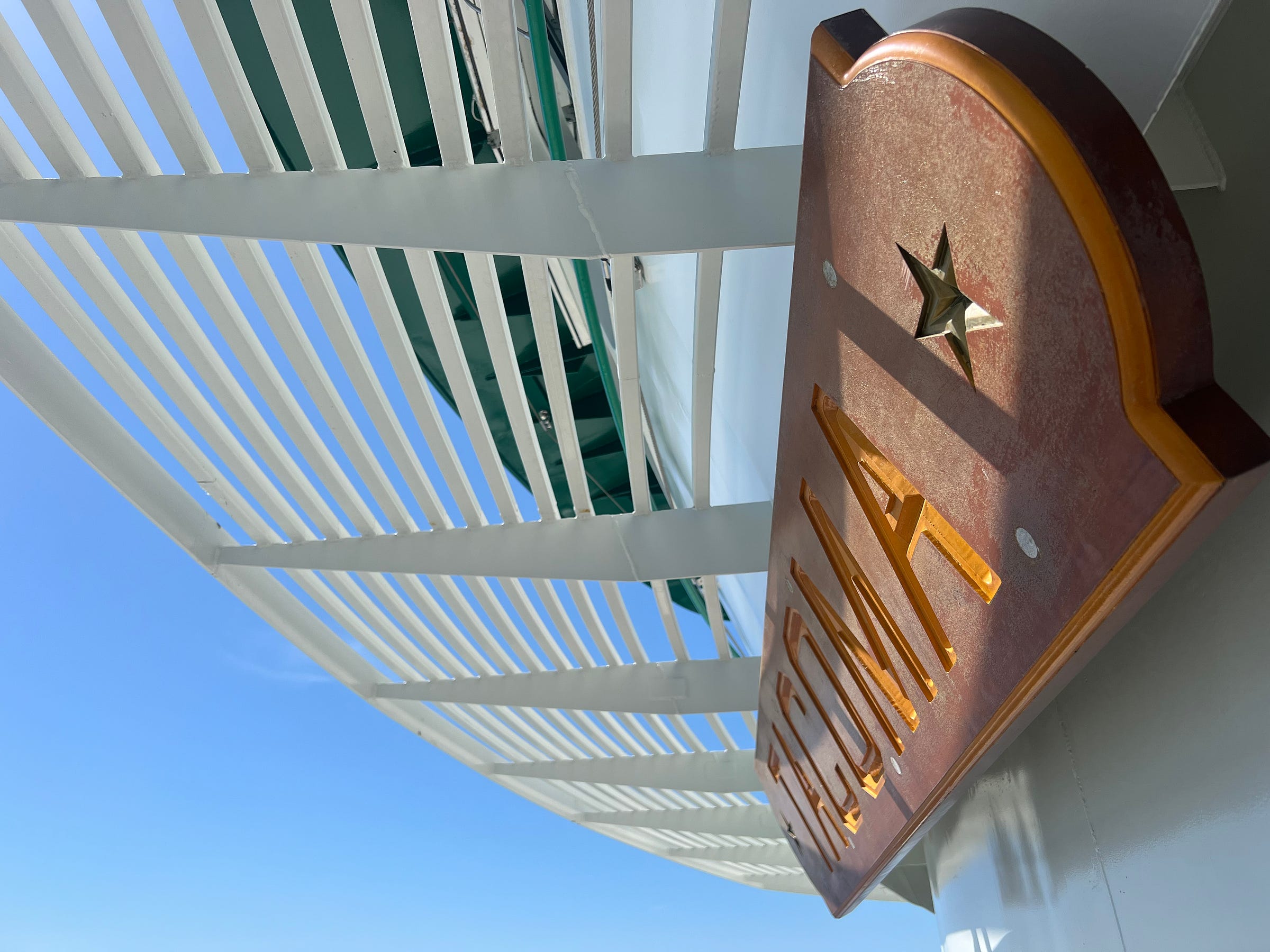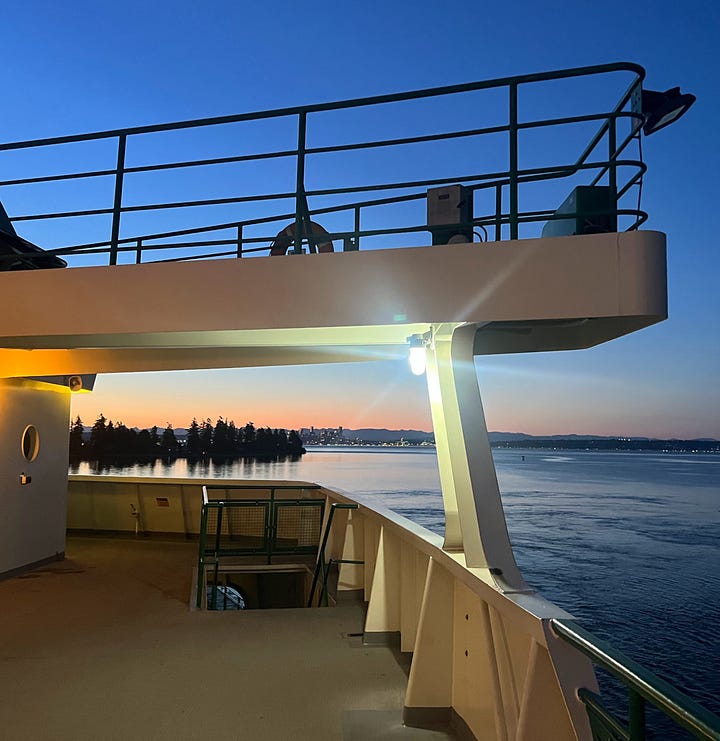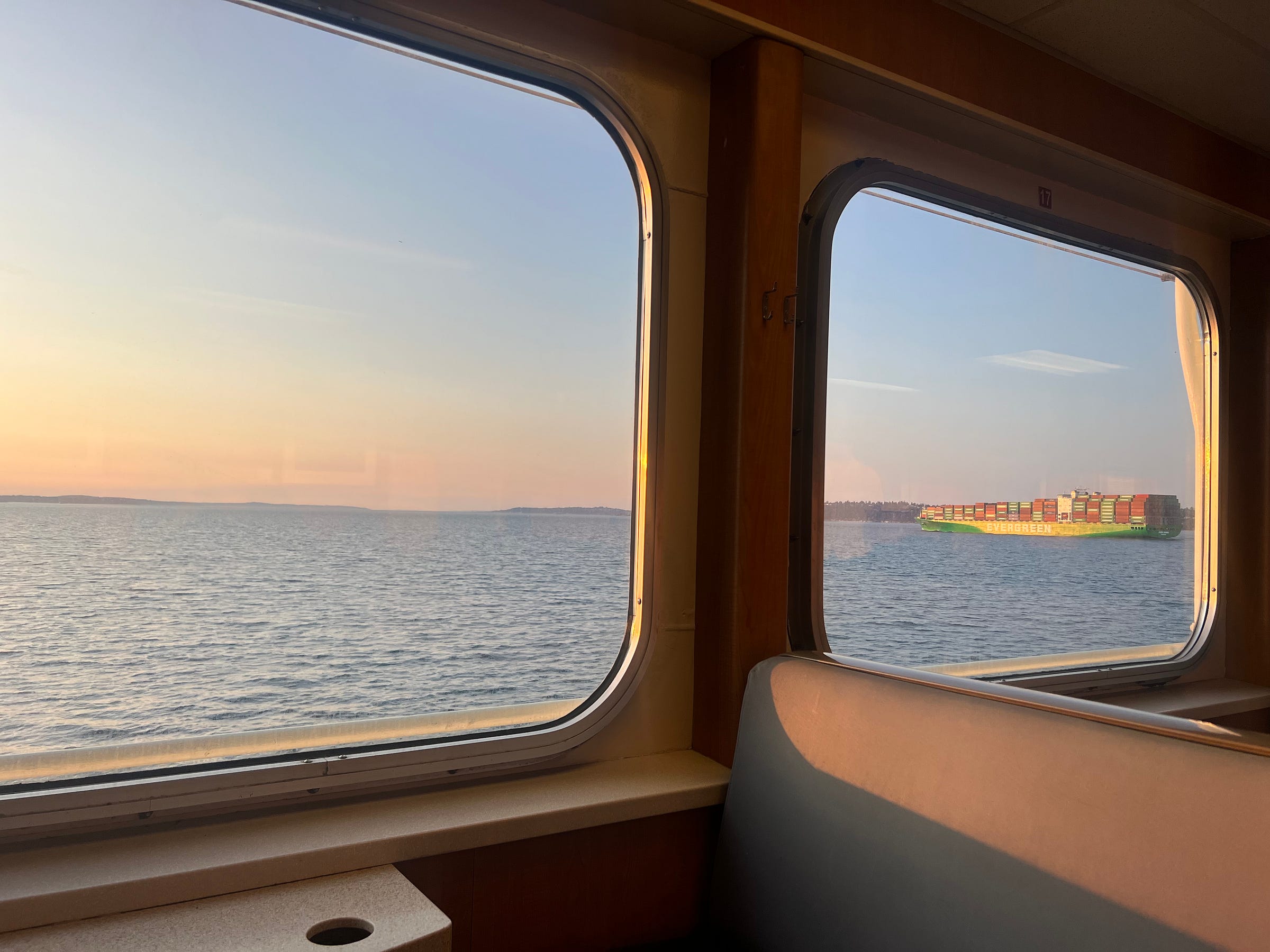Pathway to the Pilothouse, Column 3: The First Watch
Two sides of the same deck: Erica Lichty explores the support and setbacks of maritime life, and why she chooses, again and again, to stay with it.
Pathway to the Pilothouse is a monthly column by author and mariner Erica Lichty, chronicling her journey toward becoming a captain with Washington State Ferries.
Each installment offers a candid look at the realities of maritime training—the technical challenges, the strain it places on daily life, and the unexpected sense of community that emerges among those working on deck.
Erica’s perspective is rare: fewer than 3 percent of Washington State ferry captains identify as women+. Through her writing, she sheds light on what it means to enter a profession shaped by tradition—and what it takes to create space within it, not just for herself, but for those who follow.
Read the first and second editions of the column via the respective hyperlinks.
“Don’t focus on what the job isn’t. Focus on what it is—and what it could be.”
I’ll go ahead and dive right in.
My first watch. My first assignment.
Right now, I live in Olympia, Washington, but my home port with Washington State Ferries is Point Defiance, Tacoma—about 40 miles north. That designation sets the range of terminals I’m required to report to. Anything within 35 miles of Tacoma is fair game.

When you do the math, it’s a fair bit of driving.
And sometimes, to get enough hours and stay financially afloat, I take assignments even farther out.
My very first watch? Anacortes.
The ferry terminal was 152 miles from my driveway.
For context, in maritime terms, a “watch” refers to a designated period of time during which a crew member is on duty, responsible for specific tasks related to the operation, safety, and navigation of a vessel.
I was assigned to the MV Sealth, with a report time of 1550 for an eight-hour watch. That meant I’d likely be in my car heading home around midnight. Thankfully, most of my community (and my parents) are in Seattle, so I grabbed a few hours of rest before continuing my journey south the next morning
Watch 1:
Of course, I was nervous.
I showed up early, walked the quiet decks, and waited for someone in uniform. When my fellow crew finally arrived, I was pleasantly surprised—they were from my own training class.
That familiar camaraderie made all the difference. We shared our nerves and asked the “dumb” questions together, without shame.
The Able-Bodied Seamen (ABs) on deck were generous with their time and knowledge, offering practical tips and encouragement. Our Licensed Deck Officers (LDOs), including the Captain, were equally kind and patient. In fact, the Captain had been one of our onboarding instructors. He remembered my background in the Merchant Marines and went out of his way to let me know the pilothouse was a space I was welcome in—to observe, ask questions, and talk about pilotage.
That day, I was assigned as OS-1: Ordinary Seaman #1—a designation for newer crew working mainly with the ABs on the car deck, helping direct traffic and learning how to communicate with the Bosun.*
I loved it.
The movement, the air, the strategy. It felt good to be in my body, active and present. At the end of my shift, I didn’t jump straight into the car. I sat for a while. Reflected. Gave thanks. Felt my heart swell.
I belonged.
Watch 2:
My second watch was on a route known as The Triangle—the busy, tightly timed run between Fauntleroy (West Seattle), Vashon Island, and Southworth on the Kitsap Peninsula. This time, I reported to the MV Kitsap at 1230.
It was a different vibe entirely.
There was no calm onboarding, no introductions, no setting of expectations. Just a quick watch change—and off we went. When someone asked if anyone wanted to be OS-1, I volunteered—having just done it and genuinely enjoyed it.
The Chief Mate raised an eyebrow.
“Do you know what you’re getting into?”
“Nope,” I said. “But I’m ready to learn.”
This time, it was harder. The ABs were less communicative, and I had to rely on every bit of crossover knowledge from past maritime roles to get through it. I was complimented at the end of the watch—but not without some discouragement along the way.
One interaction with an LDO stood out for the wrong reasons.
I won’t go into it here. I’ve filed it away under “How Not to Lead.”
After spending so many years in advocacy—working to make this industry better—I’m now in a position to walk the talk.
I’m here to do the work. I’m here to stay.
I’m not interested in quick fixes or surface-level change. I want sustainable outcomes. I want to be a positive change agent. Period.

I had a day or two to sit with that last watch. It was triggering.
It reminded me of the reasons I once left this industry behind. But I asked myself: Am I ready to walk back into this space, knowing full well the culture it can contain?
The answer came: Yes.
Change doesn’t happen from the sidelines.
I’ve wanted to be a ferry captain for as long as I can remember. I’ve waited long enough. I’ve done the work, built the community. This is my time.
A seasoned sailor once told me: “Stop focusing on what the job isn’t. Start seeing what it is—and what it could be.”
For me, working on the ferries is about more than just water and vessels. It’s about crew. It’s about community. It’s about getting to go home at the end of the day—and still live a life.
Already, I see parts of myself reflected in other women onboard: the tugboat mariner who wanted to be home with her partner; the former medical worker from San Francisco, drawn back to the water; the grocery clerk who dreamed of captaining a vessel; the fisherwoman who had seen too much—and offered a quiet prayer for me after hearing my story.
This is my journey. And I know now, more than ever, that with any meaningful journey comes challenge. You have to know your mind. You have to know your body. You have to learn how to navigate both—and how to navigate the unseen.
You also have to understand that there may be multiple endings. That your path is yours alone, but others may walk it beside you.
And some of them might just be with you in the pilothouse when you get there.


I’ll save my current studies and coursework for the next column.
For now, I’ll leave you with this:
Everyone who reads this will take something different away.
Some of you will focus on the credentials, the schedules, the logistics of WSF.
Some will connect with the human stories—the barriers, the near-misses, the community.
Some will recognize the quiet, often invisible work of transforming systems from the inside out.
But no matter what you take away, I hope one truth remains: real-time problem solving, peer support, and community matter. They are the soul of this work, and they haven’t been given enough credit.
The advocate in me isn’t going anywhere.
See you next watch,
Erica Lichty
Editor’s Note: If you haven’t had a chance to watch the embedded video in this article, consider clicking play. While driving to her first watch shift, Erica shares her reflections on the promising future the maritime industry can hold if we work together to make it a reality. Video shot, narrated, and edited by Erica Lichty.
* The OS-1 position is not necessarily designated for a new employee. While it is often an entry-level role, some individuals build long-term careers as OSs. The title “OS-1” does not indicate rank or seniority; it is simply a job classification. In fact, it is considered the most interactive OS positions.







This is an excellent series. Proud of Erica and great work Annie for encouraging the documenting of the journey.